How to Make Sure Your Writing Lands
Write Your Way Around The World: The Story Audit Edition
If you’re new here, every week I share tips, insights and actionable ideas on writing, travel writing and green travel through the lens of a novelist and travel writer (Lonely Planet, DK Travel, etc.) in three newsletters: Storycraft, Write Your Way Around the World and The Green Travel Guide. Welcome, and thanks for coming on the journey!
The Story Audit Edition: How to make sure your writing lands
This week in Write Your Way Around The World:
How to make sure your writing lands
Sneak peek at the editing process on a book
Welcome to Travel Journal Club
Also this week
What I’m loving on Substack
Welcome to Write Your Way Around The World.
If you’re new here, a good place to start is Think You’re Not a Travel Writer? Think Again and download your free masterclass on breaking into travel writing here.
How can I sharpen my travel writing?
You’re travelling, you’re writing. Maybe you’re blogging, maybe posting here on Substack, maybe you publish with magazines or online publications. Maybe you’d like to. Or maybe you’re writing because you want to build connection and community with fellow travellers, or to create a record of your travel memories.
Whatever the reason, we all want to improve our writing. And this is where a Story Audit comes in.
I’m laying out below in part how I look at a piece of content in detail (it could be a travel story, a memoir extract, a chapter of a book) - and the steps I typically take to polish that writing. I hope it’s helpful to you for your own writing.
Keri, from My Diary Will Travel, has kindly offered to share her recent post on Prague with us to show how this works in practice.
I’ve posted some screenshots below from her article about ‘Prague - A Fairytale City’, and you can read the full article here. Thanks Keri!
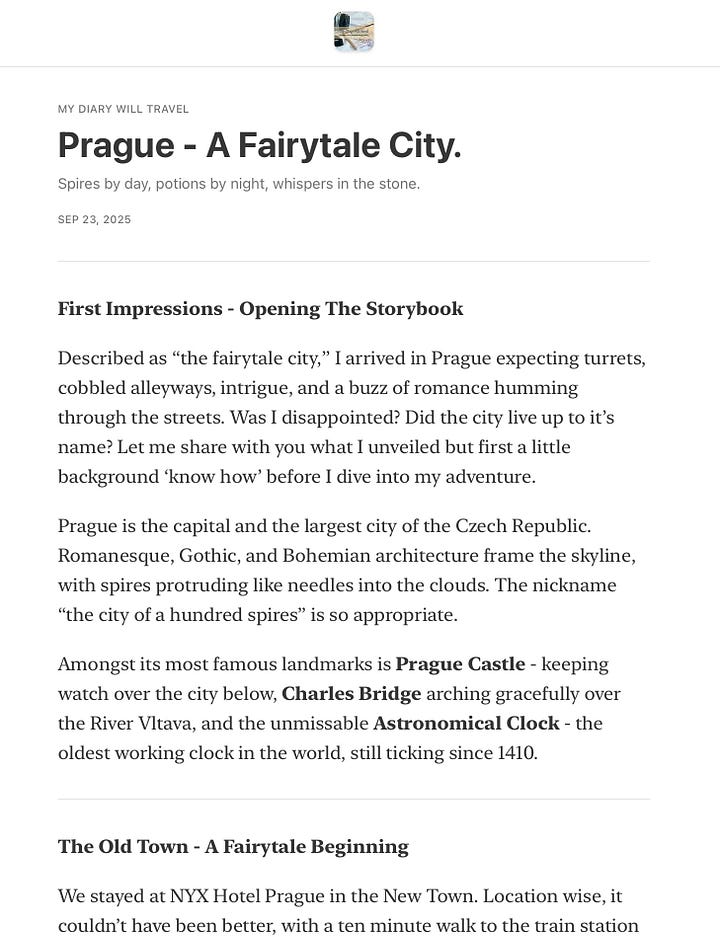
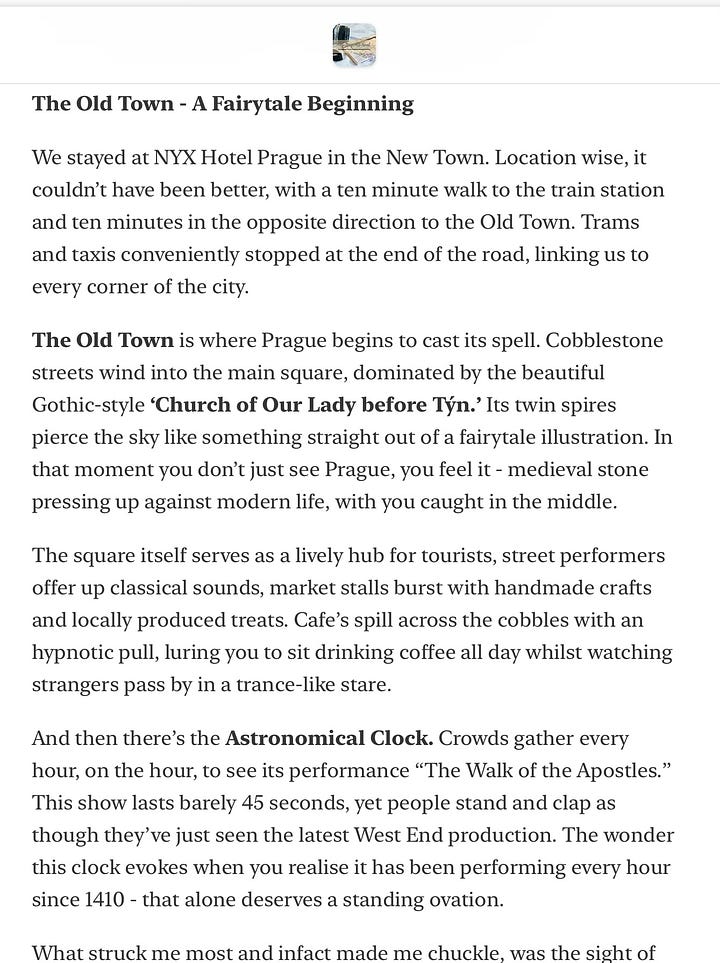
So, how does a Story Audit work?
These are some of the typical steps to work through on a Story Audit (in practice it goes deep into each of the sections below but for today we’ll just focus a little on the first three):
STORY AUDIT FRAMEWORK
Big Picture: Purpose & Concept
Tone & Voice
Structure & Pacing
Craft & Style
Content & Substance
Audience Alignment
Editorial Polish
Let’s look at the first three in detail:
1. Big Picture: Purpose & Concept
Core Idea: What is the story about beyond the destination?
Intent: What does the writer want the reader to feel, learn, or imagine?
We start by looking at the story concept. Has the article got a clear theme or angle? What’s the story really about? What mood is it seeking to create in the reader?
Keri’s piece plays with the idea of Prague as a living fairytale. So, it has a clear angle, it’s seeking to connect the reader to the dreamlike, picture-book aspects of the city’s architecture and ‘mood’.
Angle Check: Does the article deliver on its headline promise? (“A Fairytale City” → magic, wonder, atmosphere).
Here you want to think about how your story connects to the headline promise - is the subject reflected back in the tone of your writing, in the content? If not, there’s a mismatch.
Here Keri leans into the fairytale tone in her writing. She sticks with this for the subheadings throughout as well. At the same time, she’s questioning it as she goes.
Originality: Does it offer fresh insight, or rely on common tropes (“spires, cobblestones, romance”)?
Don’t deliver up what you think readers are expecting. Instead, really try to look at a place through fresh eyes. What impression does it actually create in you.
Forget about what the guidebook is saying and observe for yourself. Have we seen these images many times before? Or can you bring something new to your telling of the scene.
Have a look at Keri’s article - can you spot some fresh imagery, and personal takes on what she is experiencing? She takes the notion of ‘a fairytale city’ and is playing with that idea from the outset, questioning the idea. This brings an extra layer to the writing, moving it away from expectations or over-familiar imagery.
2. Tone & Voice
Consistency: Is the tone steady (e.g., whimsical, romantic, reflective), or does it wobble between guidebook and personal essay?
Tone and voice are intrinsically linked when you write. It can be all to easy to drift into guidebook-speak. Now, if you’re writing for a guidebook - that’s perfect. However, if you’re seeking to create something more narrative-driven, then you need to make sure it’s your voice coming through consistently on the page. Think about who you are writing for, and the intent behind the piece of writing.
Here Keri is leaning towards narrative. Phrases like “what struck me most and in fact made me chuckle” clearly put her voice on the page.
Authenticity: Does the voice sound lived-in and personal, or generic and polished?
Be really honest with yourself here. Go through paragraph by paragraph and weed out the generic.
Keri’s take on Mala Strana feels more personal. She talks about “the sheer quirkiness and twists of humour the town saves for its visitors” and then describes a few examples, backing each one up with a great photograph.
Emotional Resonance: Does it evoke a feeling, or simply describe?
The best writing will always move a reader. It goes beyond description. Think of someone like Anthony Bourdain writing about food and travel (and life and humanity) - the writing goes way beyond mere description. It is intentional. It evokes strong feelings. It’s not trying to please everyone.
Looking at Keri’s article, can you find the instances of emotional resonance in her prose? The moments that go beyond description. Moments of surprise, discomfort, connection (the conversations she describes with locals) or delight. These are what bring a piece of writing to life.
Reader Connection: Does the narrator feel like a companion, an expert, or a distant observer?
Great writing will often feel like a conversation - it’s like the writer is talking directly with you. Look to create that sense of connection when you write. Otherwise, why would the reader care?
See how Keri is connecting with her readers. She starts with a question and a bit of a quest, then takes us along with her from dawn to dusk. It’s a day-in-the-travel-life format but it’s not a dry listing point-by-point of what she’s seeing. Instead she’s engaging with what she sees, bringing in her personal impressions, snippets of history and context along the way.
3. Structure & Pacing
Opening Hook: Does the first paragraph grab the reader and set expectations?
One of the most common mistakes writers make starting out is to take too long to get into the story. There can be a lot of descriptive scene-setting. But story is action, is movement, is engagement, is cause and effect. Look at your opening paragraph and see if it’s bringing the reader right into the action. If it isn’t, cut it.
When I write novels, I’ll often cut the first couple of pages when working on tightening up drafts. The same goes for travel writing. If you’re written something narrative-driven (as opposed to following a guidebook format and brief), then jump further ahead into the story.
Flow: Are transitions between sections smooth and logical (e.g., in Keri’s article: from historical intro → personal experience → nightlife)?
Structure is your friend. The white space on the page is your friend. Headlines and sub-headings are your friends. Use them.
Keri is signposting in the way she’s laid out her article - look at how she uses the subheadings to lead us through the piece, guiding expectation, and how she’s using photos as signposts too (echoing back the story content).
Pacing: Does the story linger too long on details or move too quickly past emotional beats?
A lot of writers can struggle with how and where to end a piece of writing. Or get caught up in the detail of a particular aspect of something they’re writing. In the search for clarity, it’s easy to tip into over-explaining. Just keep it simple. If it’s not simple on the page, rewrite it. Readers love clarity. They love a writer who is confident in where they are taking them.
Much harder perhaps is to know when to go deeper on emotional moments - when to linger a little.
Read through Keri’s article looking solely at pacing - how does the story move along? How does she transition from one moment to the next? Where are the ‘feeling’ parts of the story? And how is she tying them together in the closing paragraphs?
You can do the same exercise with any piece of narrative-driven writing. Learn to spot story beats, and how they give shape and cadence to story.
Ending: Is there a sense of closure or takeaway, or does it just stop?
Again, this is something that comes partly with instinct, partly with experience: when to end a story. Endings and beginnings share much in common.
Think back to your story concept - what was the overarching story you were seeking to tell? Echo that back in the closing notes if you can. Better still, has there been some kind of transformation (this doesn’t have to be something big, it can be a small shift).
Look at how Keri reflects at the end about how the way she sees the city (travelling now in her 50s) is so different to how she experienced it previously. The story has come full-circle.
If you’ve found that a helpful intro for how to start thinking about your own writing, and want to know more about how a Story Audit could help you sharpen your writing, drop me a DM for info.
Behind-the-scenes peek at the book editing process
Writing a book can be pretty messy. Getting the first draft down is really only the beginning.
Here I’m sharing a couple of photos of notes from the editorial process on my novel Lenny - the before and after moments. It’s all too easy to think that writing a novel, or a collection of travel stories or a non-fiction book, is a solitary process. Whether you’re trad or indie publishing, if you’re working on a book project, you’ll still benefit from working with editors, copyeditors, designers, and marketing/PR support. The story is just the first step.
Some edit notes and the final version:

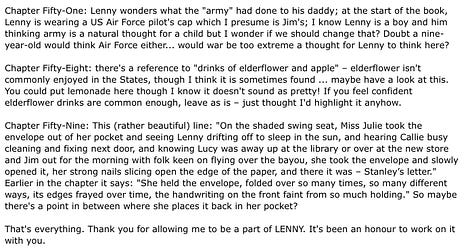
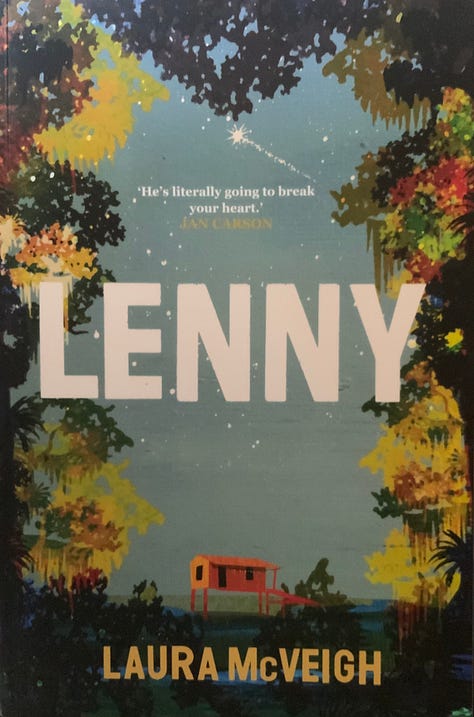


Welcome to Travel Journal Club
Not everything has to be written for publication. Sometimes we write to capture memories, or just as a keepsake. Travel Journal Club is not about grand adventures or perfect notebooks, just a quiet cosy space to gather the moments that move us. Each week, I’ll send a short prompt, something to nudge your memory or open a window onto a place you’ve loved. You can write as little or as much as you like - a line, a paragraph, a feeling. Think of it as a way to keep your stories.
There’ll also be travel book recommendations, and interviews with other travel writers, photographers or adventures. It’s about giving yourself a quiet space for reflection and connection. And to share your journaling with others if you wish.
This week’s prompt: Record a map or route you travel in words, noting landmarks and impressions.
My notebooks
Travel journaling isn’t about pretty pages. I take a small notebook with me and jot down details, questions, names, places, story ideas, quotes - the things that catch my attention as I travel. How do you capture your travel ideas and impressions?

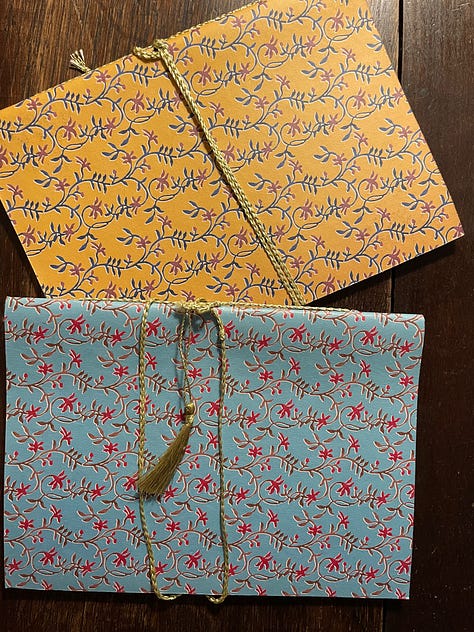

In Case You Missed it
In case you missed it - in Storycraft I wrote about writing lessons on attention and art from reading Arundhati Roy’s The God of Small Things, a beautiful novel set in Kerala, and shared a piece I wrote recently on travelling by houseboat on the Kerala backwaters.
The Green Travel Guide focused on Future-Proof Travel: How to Go Green for 2026.
Over on Notes I shared some of my favourite travel-related books, all fine examples of writing with purpose. Also shared a peek at travel journals and notes from Patrick Leigh Fermor, Freya Stark and Laurie Lee.


I shared a few more adventures from the upcoming book, The Ultimate Green Travel Guide (publishing November).
And this week, saw the launch of Write With Purpose. Thanks to those who’ve signed up already! If you’re keen to develop more purpose in your writing and are thinking of signing up, note the founding rate is available only until end of October, then it’ll go up to reflect the programme depth and content. Full details here.
Things I loved on Substack this week
Just a few of the things that stopped the scroll for me this week:
I enjoyed Nomad Life’s travels round the ‘Stans - one of my favourite parts of the world. Really interesting post on Turkmenistan here.
Loved Heena Narula’s post on travels to Dingle in Ireland all about the warm welcome there. As someone from Ireland, that makes me happy to hear!
I think Patrick M. Lydon’s Korea posts and illustrations are beautiful and thoughtful, and I particularly enjoyed this one on cultural bridges.
The Travel Book Club have a lovely Fall reading list - with John Banville’s Venice, Megha Majumdar’s near-future Kolkata, and Anna North’s Bog Queen plus more.
And many, many more… Thank you so much to all who have read, commented, subbed, liked, shared and restacked. Greatly appreciated! ❤️
What You’ll Learn Here — Every Tuesday
Every Tuesday in Write Your Way Around The World, I share:
Practical guidance on writing craft, pitching, editing, and freelancing
Encouragement for staying resilient and consistent as a writer
Real talk about money, mindset, rejection, and career-building
Inspiration from great travel writing and emerging trends
Resources to help you go further, faster
Future weeks will dig deep into how to make a living doing this, how to get published, how to find your niche/s or not (just write what you love), how to turn your travel notes into paid work. Let me know which topics you would like to know more about.
Happy writing!
Laura
Laura McVeigh
Author, Travel Writer, Storytelling Coach
lauramcveigh.com | lauramcveightravel.com | travel-writing.com | greentravelguides.world
Laura McVeigh is an internationally bestselling Northern Irish novelist and travel writer. Her work is widely translated. Her latest novel Lenny is set between Libya and Louisiana. She has authored books for Lonely Planet, DK Travel, bylines in the Irish Times, Irish Independent, featured by the BBC, Newsweek, New Internationalist & many more. A former CEO for a global writers’ organisation, she has worked with writers from 145 countries. She is founder of Travel-Writing.Com and Green Travel Guides. Laura writes on storytelling, travel writing and mindful travel on Substack.




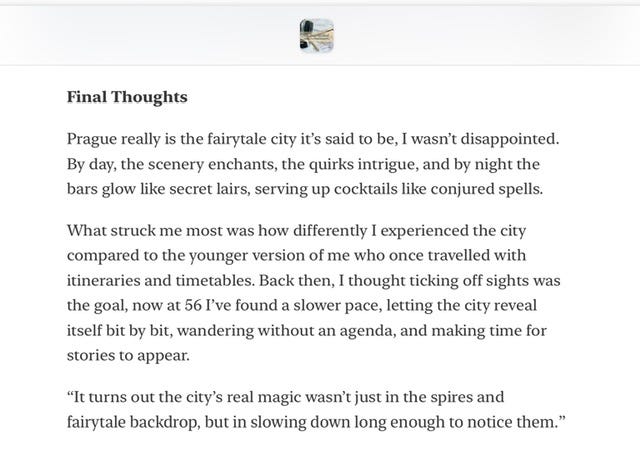

I’m truly honoured that you chose to feature my Prague piece as part of your Story Audit Laura. As a newbie to putting words on paper, writing purely as a hobbie I cant tell you the confidence and encouragement this has given me. The breakdown was so well explained and has given me a fresh perspective on how to present my travel writing in the future. Thank you for such generous feedback and for your time.
Brilliant piece, Laura — I love how you broke down the Story Audit into layers that actually feel doable. We travel full-time and write about it, and your “beyond the destination” reminder really hit home — it’s what keeps our stories from turning into itineraries.
Thank you for sharing such a generous framework. I’ll be rereading this one next time I’m editing on the road — probably somewhere between a pint and a paragraph.